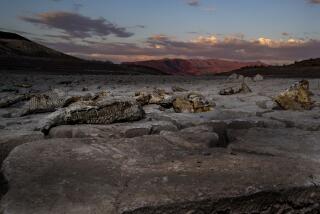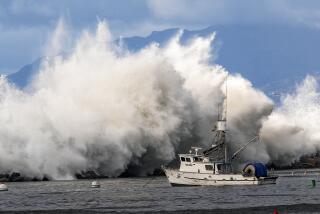Heavy rains in Texas, Oklahoma fuel hope for California drought relief
Reporting from HOUSTON â Look east, California.
Five years of extreme drought have come to a dramatic end in Texas and Oklahoma as a month of heavy rains has replenished reservoirs, dampened parched soil across both states and unleashed floodwaters on vulnerable residents.
A downpour this weekend pushed rivers far over their banks in central Texas, where flooding devoured hundreds of rural homes between Austin and San Antonio. At least 2,000 people fled to emergency shelter as helicopters rescued residents from rooftops and bridges snapped apart like Graham crackers. At least one person was dead and three others were missing as of Sunday afternoon.
The nonstop Texas-Oklahoma rains are probably being influenced by a building El Niño in the eastern tropical Pacific Ocean, whose warm waters tend to bring rain to the southern U.S., said Bill Patzert, a climatologist at NASAâs Jet Propulsion Laboratory in La Cañada Flintridge.
If a full-blown El Niño develops, that could mean rain for Southern California next winter, and it could mean trouble too, he said.
âThe headlines that youâre writing today about Texas and Oklahoma, you could be writing about California in January,â Patzert said. âThereâs something to remember about El Niño â heâs a good boy and heâs a bad boy because he can deliver drought relief thatâs much-needed. But all that water coming so fast is like trying to catch water out of a fire hose with a champagne glass.â
He also cautioned Californians against putting too much hope in El Niño to end the stateâs drought.
âEverybody is thinking of El Niño as the great wet hope, as the great drought buster,â he said. âThe building El Niño is having some impact on the heavy weather weâre seeing in Oklahoma and Texas, but weâre a long way from seeing the equivalent rains in California next winter.â
The Texas flooding comes after months of wetter-than-normal weather and less than a week after officials logged an absence of extreme drought in any part of Texas or Oklahoma for the first time in five years.
The category âextreme droughtâ means that officials expect major crop and pasture losses along with widespread water shortages or restrictions.
At the peak of Texasâ brutal drought in 2011 â which drew comparisons to the Dust Bowl days of the Great Depression â 97% of the state was under extreme drought or worse. A year ago, it was 40%. Now, itâs 0%. The figures in Oklahoma are similar.
Thatâs compared with 67% of California under extreme drought or worse right now.
In Texas, some ranchers sold or slaughtered their cattle as pastures withered and hay got more expensive. John Welch, 64, shipped cattle to greener pastures in Nebraska, Montana and Wyoming.
Now the rain is back, and so are Welchâs cattle.
âWeâve brought them all back and still have excess grass. Itâs been the fastest turnaround you can imagine,â Welch said while tending his cattle Sunday.
Welch added: âThe wheat pasture is just phenomenal, the best itâs been in years because of all the rain weâve had, from the Panhandle all the way down into central Texas. Weâve gone from too many cattle and not enough grass to lots of grass.â
The drought is not totally over. Texas A&M professor and state climatologist John Nielsen-Gammon noted that âa good portion of the state is still under mandatory drought restrictions,â but many areas have also seen âwell above normalâ rain levels, refilling reservoirs in the Dallas area while those in west Texas, the Hill Country and Austin âhave started inching up.â
âWeâve seen drought disappearing week by week,â he said.
In west Texas, which saw some of the worst drought, a reservoir serving Abilene, Austin and San Angelo was still at a historic low, he said. For the entire state to emerge from the drought, it will take not only more rain, but rain in the dry spots, he said.
In Oklahoma, weeks of heavy rains have put an exclamation point on years of drought that forced some cities to institute mandatory water restrictions.
With a week left in May, Oklahoma City has already notched its wettest month ever, and more than 70% of rivers in the area were forecast to hit flood levels sometime next week, according to Vivek Mahale, a meteorologist for the National Weather Service in Norman.
In one bizarre incident early this month, an Oklahoma City woman, taking cover from a storm, drowned after her tornado shelter flooded. Another tornado shelter in Norman emerged from the ground like a submarine after the ownerâs yard flooded.
This weekend, Claremore, Okla., firefighter Jason Farley died, reportedly after getting swept away while trying to rescue flood-trapped residents, and flash flooding is expected to continue Monday as more rain falls on the already saturated state.
âThey may see a continuation of some flooding problems as we go into June and July,â said Carl Erickson, a senior meteorologist for AccuWeather.com, adding that El Niño is probably âthe longer-term factor into the overall patternâ of increased rain across the nation.
Sundayâs flooding in Texas was especially dramatic in the town of Wimberley, population 2,582, where Hays County officials estimated more than 350 homes have been destroyed.
The Blanco River rose from about 5 feet at 10 p.m. Saturday to more than 40 feet at 1 a.m., well past its record high of 33 feet, according to National Weather Service river data.
âWe have whole streets that have maybe one or two houses left on them, and the rest are just slabs,â Hays County emergency management coordinator Kharley Smith said in a televised news conference Sunday.
In California, the 1997-98 El Niño brought floods, mudslides and disaster declarations in at least 40 counties as the state was pounded with month after month of rain.
Patzert, the NASA climatologist, said El Niño rains for California this year were âno sure bet.â
But after the drenchings of Oklahoma and Texas, Patzert added, âThis might be a preview, if this El Niño continues to develop, of what we might see in Southern and Central California next winter.â
Still, he noted that Californiaâs water situation, which is so dependent on a deep snowpack, is different from Texas or Oklahoma.
âEl Niño is not a drought buster â it provides a lot of excitement and a lot of mudslides in Southern and Central California, but it doesnât do much for Northern California, and thatâs where we need it,â Patzert said, emphasizing the stateâs meager snowpack.
California water officials had planned to make the trek to the Sierra Nevada to conduct their monthly snowpack measurement on May 1, but called it off because, for the second consecutive month, there wasnât any snow to measure.
This is why Patzert emphasizes the complexity of Californiaâs drought.
âEl Niño essentially drenches the southern tier of the United States, so you often have below normal rainfall in Northern California, which is where we get most of our water,â Patzert said.
Welch, the Texas rancher, wasnât sure what Californians could learn from his experience.
âIt is all at the mercy of the Good Lord,â Welch said. âYou just donât know until itâs over with what the drought will be. I donât know what the lesson is â persevere, I guess.â
Twitter: @MattDPearce
Twitter: @mollyhf
Pearce reported from Los Angeles and Hennessy-Fiske from Houston.
More to Read
Sign up for Essential California
The most important California stories and recommendations in your inbox every morning.
You may occasionally receive promotional content from the Los Angeles Times.












